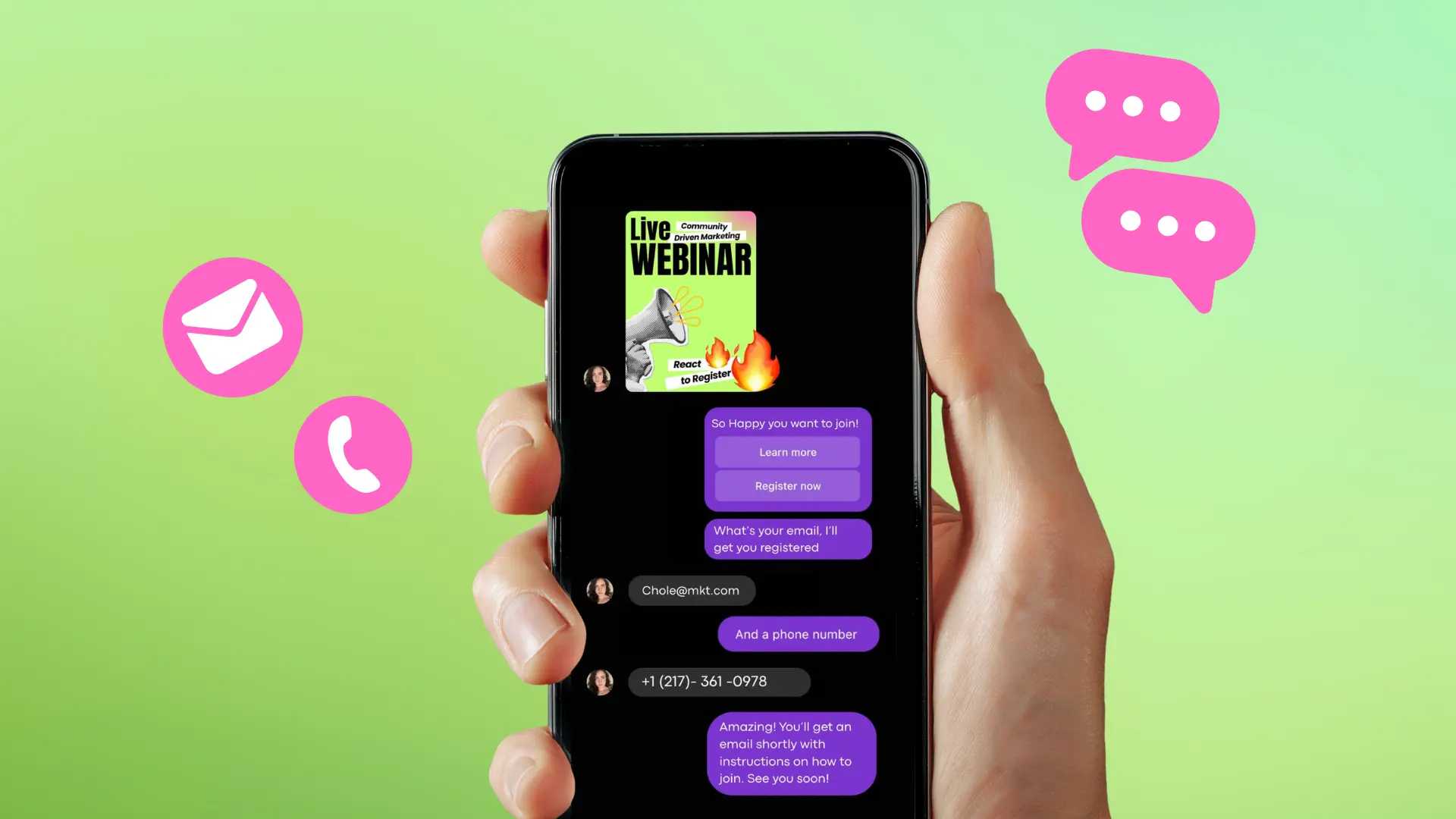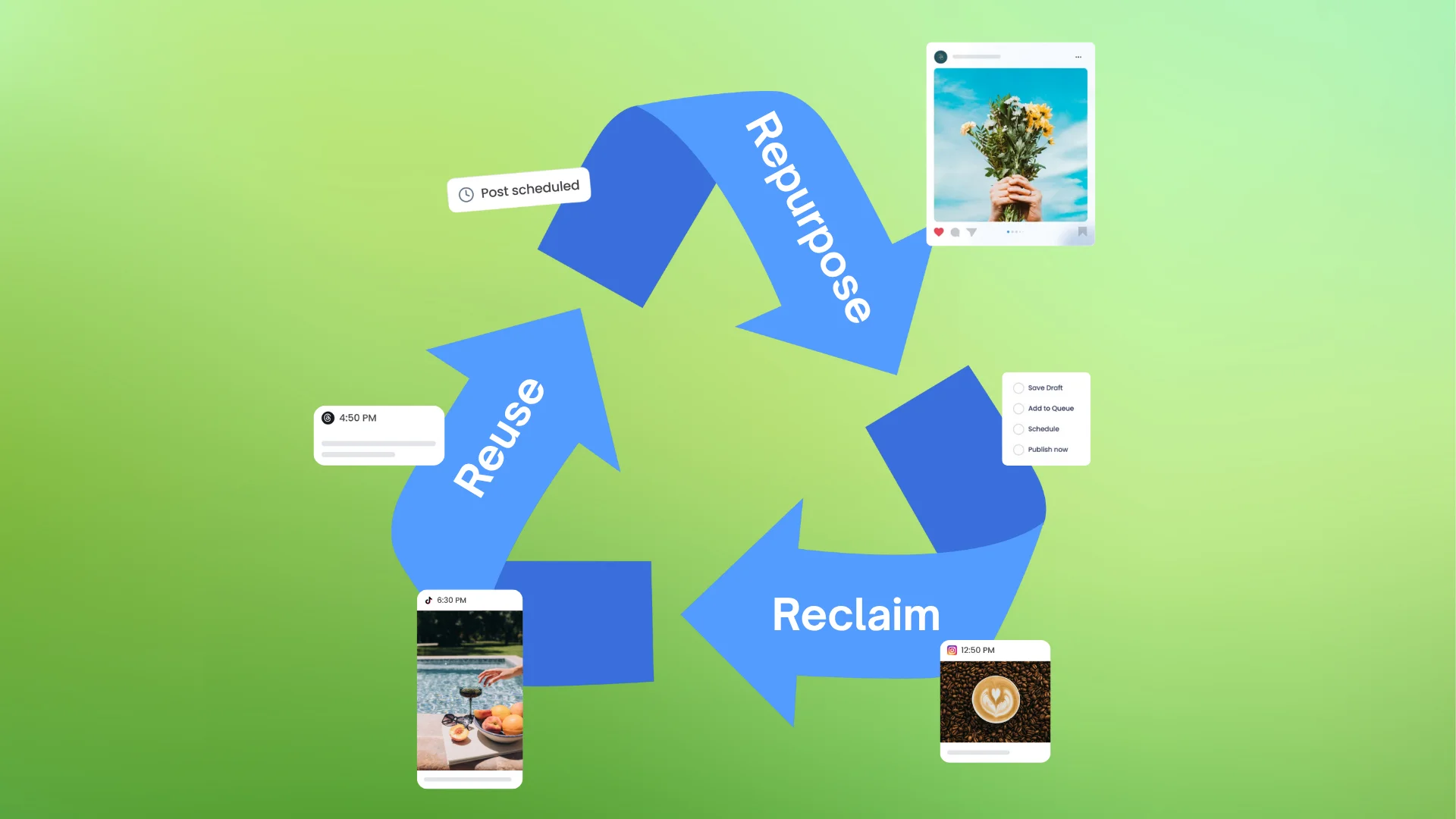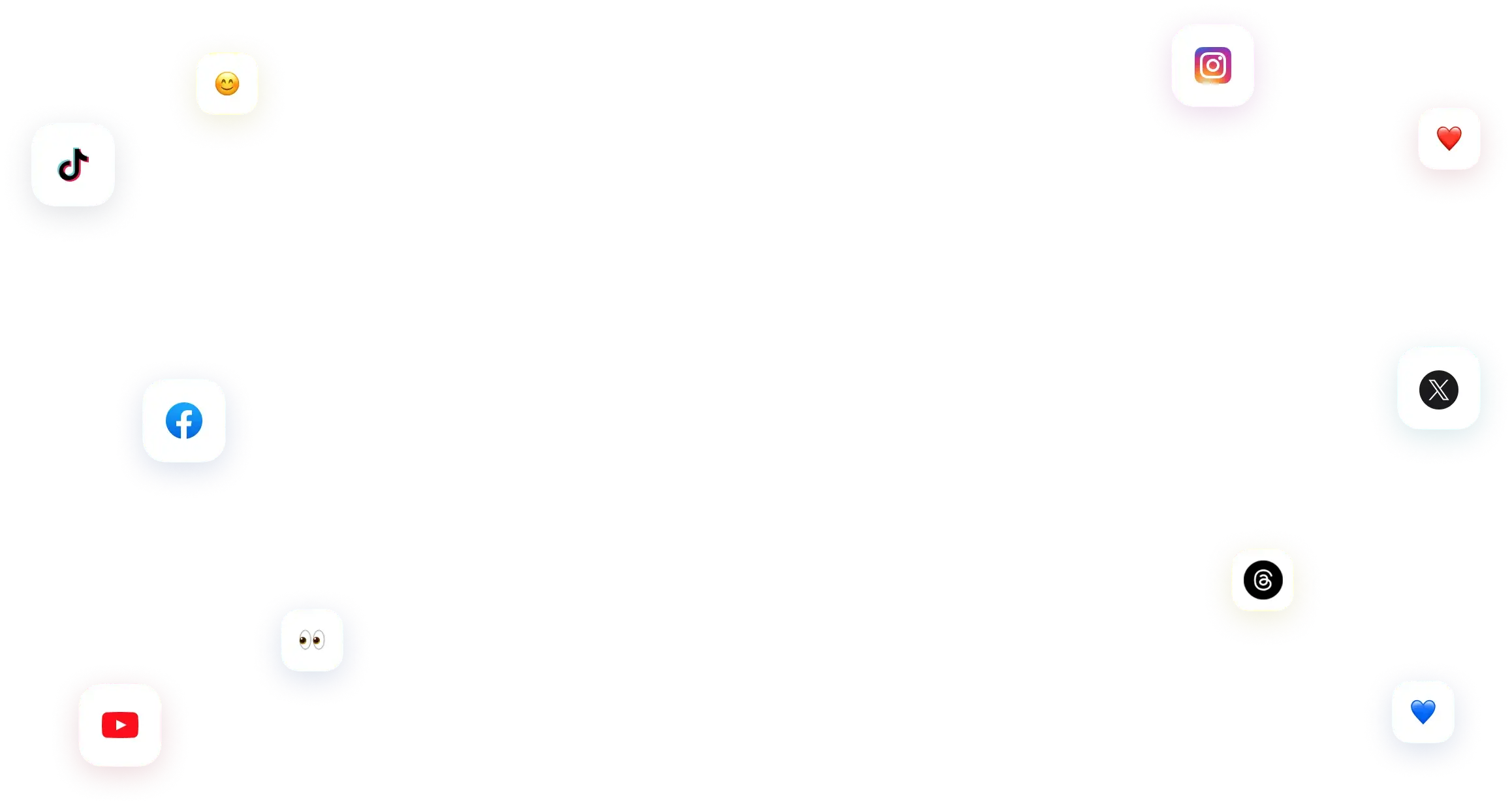New

Turn Your DMs Into Lead Gen!
Learn how to collect lead data from your DMs such as email addresses, phone numbers, and more right from your social inbox. If you are not yet automating your DMs your competitors are outpacing you.

How Something Social Saved 75% of Their Time and Increased Revenue by 15%
See how a fast-growing agency improved operations, cut down hours of manual work, and unlocked new revenue opportunities with Vista Social.
New

50 Unique Social Media Ideas for Consistent Content Creation
Discover 50 unique social media post ideas to engage your audience, grow your brand, and maintain a consistent content strategy with ease!

Mastering Content Reuse: The Key to a Consistent and Sustainable Posting Strategy
Published on August 13, 2025
8 min to read
Content Recycling Analytics to Find Your Best Performing Posts
Summarize with AI


Table of Content

Most marketers create new content constantly while their best-performing posts collect digital dust. However, content recycling analytics can change this wasteful approach. Research shows that only 20% of bloggers report strong results, down from 30% five years ago, yet marketers continue focusing primarily on creating fresh material.
Content recycling analytics involves systematically measuring and analyzing your existing content performance to identify which pieces deserve a second life. Unlike traditional analytics that focus on recent posts, this approach examines historical data to uncover hidden gems that can drive results again.
In 2025, with content saturation at an all-time high and 90% of content marketers planning to use AI, smart marketers are turning to data-driven recycling strategies. This framework helps you maximize ROI from content you’ve already created while reducing the pressure to constantly produce new material.
But what exactly should you be measuring to make these recycling decisions?
Table of contents
What are Content Recycling Analytics?
Content recycling analytics represent a strategic approach to content performance measurement that extends beyond typical post-publication tracking. While standard analytics focus on immediate metrics like views and likes, recycling analytics examine long-term patterns, cross-platform performance, and conversion sustainability.
This approach matters because traditional content marketing operates on a “create and forget” model. Companies publish content, track initial performance, then move on to the next piece. However, the most successful content marketing strategies recognize that great content compounds over time when properly recycled and refreshed.
Furthermore, content recycling analytics help maximize your content investment ROI. Creating quality content requires significant resources—research, writing, design, and promotion. By identifying which pieces continue generating value months or years later, you can amplify successful investments rather than starting from scratch.
The connection between data-driven recycling and business growth shows measurable results. Research indicates that 72% of marketers report increased engagement from repurposed content, while repurposing can cut down content creation time by up to 70%. Additionally, recycled content often performs better because it’s already proven to resonate with your audience.
Current trends show that successful content recycling requires more sophisticated measurement approaches. Gone are the days when you could rely on simple view counts. Today’s recycling analytics must account for multi-platform performance, audience evolution, and changing algorithm preferences.
5 Key Metrics for Content Recycling Analytics
1. Engagement Rate Consistency
Engagement rate consistency measures how well your content maintains audience interaction over extended periods. Unlike viral content that spikes then dies, consistently engaging content shows sustained value that makes it perfect for recycling.
To measure this, track your content’s engagement rate across different time periods—week one, month one, three months, and six months post-publication. Content that maintains above-average engagement rates after three months typically indicates evergreen appeal worth recycling.
Look for content where the engagement rate decline is gradual rather than sharp. For example, a blog post that starts with 8% engagement and maintains 5% after six months shows better recycling potential than one that drops from 15% to 1% within a month.
2. Cross-Platform Performance Indicators
Cross-platform performance reveals content versatility—a crucial factor for successful recycling. Content that performs well across multiple channels demonstrates broad appeal and adaptation potential.
Track how the same piece performs when shared on LinkedIn, Twitter, Facebook, and Instagram. Note which formats work best on each platform and which messages resonate across different audiences. Content that succeeds on three or more platforms usually contains universal appeals worth recycling.
Additionally, monitor platform-specific engagement patterns. A blog post might generate strong LinkedIn discussion while the same content as an infographic performs better on Instagram. These insights guide your recycling format decisions.
3. Conversion and Click-Through Rates
Beyond vanity metrics, focus on content that drives actual business results. Track click-through rates to your website, email signups generated, and conversion to customers or leads. Content that consistently converts visitors into subscribers or customers represents your highest-value recycling opportunities.
Monitor the full conversion funnel for each piece of content. Sometimes lower-engagement content drives higher conversions, making it valuable for recycling despite modest social metrics. This data helps prioritize business-impact content over purely engaging pieces.
Furthermore, examine the quality of traffic generated. Content that brings visitors who spend more time on your site, visit multiple pages, or return frequently indicates higher recycling potential than pieces generating quick, single-page visits.
4. Audience Retention and Return Engagement
Measure how often people re-engage with your content over time. This includes return visits to blog posts, repeated shares of social content, and ongoing comments or discussions. Content that generates return engagement shows lasting value worth recycling.
Track metrics like returning visitor percentages for blog content and repeated engagement patterns on social posts. Content that people reference, bookmark, or share multiple times demonstrates sustained value and recycling potential.
Also monitor how recycled content performs with existing audiences versus new audiences. Sometimes old content performs better with fresh eyes, indicating expansion opportunities through recycling efforts.
5. Seasonal Performance Patterns
Try Vista Social for Free
A social media management platform that actually helps you grow with easy-to-use content planning, scheduling, engagement and analytics tools.
Get Started NowIdentify whether your content performs better during specific seasons, months, or days of the week. This timing data helps you plan recycling campaigns for maximum impact. Some content shows consistent year-round performance, while others have clear seasonal peaks.
Track performance patterns across at least 12 months to identify reliable trends. Content with predictable seasonal spikes can be recycled strategically before peak periods. Meanwhile, evergreen content with steady performance can be recycled anytime to fill content gaps.
Furthermore, examine how external events or industry cycles affect content performance. B2B content might perform better during specific business quarters, while consumer content could align with shopping seasons or cultural events.
[Must Read: Social Listening Analytics: A Complete Guide]
Vista Social: Your Complete Content Recycling Analytics Solution
Vista Social transforms content recycling from guesswork into data-driven strategy with comprehensive analytics that track performance across all your social media platforms. Unlike native platform analytics that only show individual post performance, Vista Social provides cross-platform insights that help you make informed recycling decisions.
The platform’s analytics dashboard helps you identify patterns in your content performance, making it easier to spot potential recycling opportunities. You can see which content types perform best on different platforms and track engagement trends over time.
Furthermore, Vista Social’s reporting features help streamline the recycling process by organizing your content performance data in one place. This centralized approach makes it easier to compare content across platforms and identify your highest-potential recycling candidates.
Vista Social’s scheduling and publishing tools also make it simple to execute your recycling strategy once you’ve identified high-performing content. You can plan strategic republication campaigns and track their performance all from one central dashboard.
Additionally, the platform helps you maintain consistency across multiple social media channels while adapting content for each platform’s unique audience and requirements.
How to Build Your Content Recycling Analytics Framework
Building an effective content recycling analytics framework doesn’t have to be overwhelming. Here’s a proven step-by-step approach based on successful strategies from companies like HubSpot and CoSchedule:
- Set up comprehensive tracking for all your content: Install Google Analytics 4 and configure it to track engagement properly. Set up scroll depth tracking (25%, 50%, 75%, 100%) and time-based events to see how people actually interact with your content. Additionally, connect Google Search Console to get the complete picture of how your content performs in search results.
- Create a systematic content inventory and audit: Use tools like SEMrush Site Audit or manually crawl your website to create a master spreadsheet of all your content. Include URL, title, publish date, content type, and current performance metrics. Then categorize each piece as high potential (evergreen, comprehensive guides), medium potential (seasonal content), or low potential (outdated content) for recycling.
- Establish performance thresholds based on industry benchmarks: Use these evidence-based minimums to identify recycling candidates: 500+ monthly sessions, 50%+ engagement rate, average session duration over 2 minutes 30 seconds, and bounce rate below 44%. For social content, look for LinkedIn posts with 2.8%+ engagement rate, Instagram 2.0%+, and Facebook 1.4%+.
- Track content lifecycle patterns and set automated alerts: Monitor how your content performs over time: growth phase (0-6 months), peak performance (6-12 months), plateau (12-18 months), and decline (18+ months). Set up alerts for content showing 20% or more traffic decline over 6 months, as these pieces often benefit most from recycling efforts.
- Calculate content recycling ROI to prove business value: Track your investment in recycling (e.g., editing time at $50-150/hour, design updates at $25-75/hour) against returns (e.g., traffic increases, lead generation, revenue attribution). Furthermore, successful content recycling typically delivers 200-400% ROI for blog content refreshing, making it easy to justify continued investment in these efforts.
Common Mistakes in Content Recycling Analytics
Even with the best intentions, marketers often make critical errors that undermine their content recycling efforts. Here are the most common mistakes to avoid:
- Over-relying on vanity metrics: Focusing solely on likes, shares, and comments without considering business impact. High engagement doesn’t always translate to business results, so balance social metrics with conversion and revenue data when making recycling decisions.
- Ignoring context and audience changes: Assuming content that performed well two years ago will automatically work today. Industry changes, audience evolution, and platform algorithm updates can significantly impact relevance, so always evaluate current context when recycling older content.
- Recycling without refreshing insights: Simply reposting old content without updating statistics, adding recent examples, or incorporating new perspectives. This lazy approach rarely generates the same impact as properly refreshed content that maintains its core message while adding fresh value.
- Missing cross-platform opportunities: Assuming that poor performance on one platform means content won’t work elsewhere. Different platforms have unique audiences and algorithms, so content that fails on Twitter might excel on LinkedIn with proper adaptation.
- Focusing on short-term performance only: Making recycling decisions based on immediate post-publication metrics without considering long-term value patterns. Some content gains momentum over time, while others peak quickly then fade.
Turning Analytics into Action: Your Content Recycling Strategy
Prioritize content for recycling based on a combination of performance metrics and business alignment. High-performing content that supports current business goals should receive recycling priority over popular but irrelevant pieces.
When refreshing high-performing content, update statistics, add recent examples, and incorporate new insights while maintaining the core message that originally resonated. This approach preserves what worked while adding fresh value for both returning and new audiences.
Moreover, scale your recycling efforts gradually. Start with your top 10 performing pieces and develop systematic recycling processes before expanding. This approach helps refine your methods and measure improvement without overwhelming your content production capacity.
Track recycling performance against original publication metrics to measure improvement and optimization opportunities. Sometimes recycled content outperforms original publication due to better timing, improved distribution, or audience growth.
[Must Read: A Complete Guide to Social Media Content Planning]
Start Using Content Recycling Analytics Today
Content recycling analytics transform wasted content investments into ongoing business assets. By systematically measuring performance patterns and identifying recycling opportunities, you maximize ROI from every piece you create.
The key is starting with proper measurement frameworks and focusing on metrics that drive business results. Track engagement consistency, cross-platform performance, conversion rates, audience retention, and seasonal patterns to make data-driven recycling decisions.
Your best content deserves more than a single moment in the spotlight. Use analytics to identify these hidden gems and give them the strategic recycling they deserve for sustained business growth.
P.S. Vista Social is a powerful all-in-one social media management platform designed for marketing agencies, freelancers, and social media managers. Our advanced analytics tools help you track content performance across platforms and identify recycling opportunities that drive real business results.
About the Author
Content Writer
Russell Tan is a content marketing specialist with over 7 years of experience creating content across gaming, healthcare, outdoor hospitality, and travel—because sticking to just one industry would’ve been boring. Outside of her current role as marketing specialist for Vista Social, Russell is busy plotting epic action-fantasy worlds, chasing adrenaline rushes (skydiving is next, maybe?), or racking up way too many hours in her favorite games.
Read with AI
Save time reading this article using your favorite AI tool
Summarize with AI
Never Miss a Trend
Our newsletter is packed with the hottest posts and latest news in social media.

You have many things to do.
Let us help you with social media.
Use our free plan to build momentum for your social media presence.
Or skip ahead and try our paid plan to scale your social media efforts.
P.S. It will be a piece of cake 🍰 with Vista Social
Subscribe to our Newsletter!
To stay updated on the latest and greatest Social Media news. We promise not to spam you!


